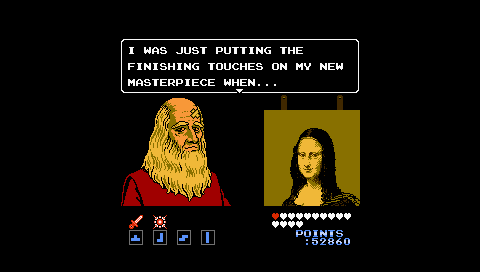Startropics and Other Recent Business
October 21st, 2016
A few months ago I played through Startropics with my friends over at the VG Commune. We recorded a couple of podcasts together and I also wrote up a rough photo diary of the two Startropics games. In the first podcast we discuss static and dynamic gameplay mechanics and how the grid-based gameplay makes the game very clean. In the second podcast we zoom out from the minute-to-minute gameplay and observe the flow between the game’s chapters. I thoroughly enjoyed the discussion and I’m sure you will too. The photo diaries are a bit rough, but I think they’re worth sharing as well.
This isn’t the first time that I’ve podcasted with the VG Commune. We’ve previously discussed Super Mario Land 2 levels, optional challenges in Wave Race 64, and the nature of two-dimensional space in The Firemen. Greg, aka Golem, has also been putting together videos out of some of our Super Mario Land 2 level discussions, so I’d urge you to check them out and follow him for more videos in the series. Although the DP blog is relatively quiet at the moment, I have been working away in the background over the past few months, so as always stay tuned. 🙂
The Path of Least Resistance
October 8th, 2016
It is as though we spend our whole life resisting, in search of the path of least resistance. Learning, though, requires that we abstain from the easy path and submit ourselves to struggle. One of the responsibilities of a teacher is to break through a student’s defences, find their way through to the dark recesses of their brain, and turn off the hidden switch labelled “resist”. Unfortunately this task is no easy feat and often requires the right mixture of good planning, good execution, and luck. When it does work, though, and students develop that hunger for challenge, well, that’s when the magic happens.
During a shift in semesters my favourite class had been reduced to two students, and one day only one of the two showed up. The 7-year-old girl in attendance was highly capable, but had a refusal complex where she would not participate in any of the classroom activities because they were “too simple”. The opposite was true. She was afraid of being challenged and would invariably give up every time the going got tough. Taking advantage of her role as the only student in the class, she refused to cooperate for the first half of the lesson.
In the second half, though, something clicked. I introduced my Bag, Beg, Big, Bog, Bug phonics game and ran her through variant one to eight. That is to say, she learnt how to transcribe three- and four-letter words in about 30 minutes—from nothing! The activity’s cyclic scaffolding gave her the confidence to power through to the more difficult challenges. The change in her behaviour was immediately apparent. She stopped giggling, stood upright, listened attentively, and did exactly as told. It was as though she was under hypnosis—which is, of course, true, as she was under the spell of a well-crafted mental challenge. She stayed focused for the remainder of the lesson until her parents arrived for the parent’s meeting, where she skipped out of the classroom as her usual self.
When I reflect on my own time at school and throughout life I regret that I didn’t give in to some things earlier. I guess it takes us all some time to accept the work involved in developing ourselves, and even then we’re not always accepting of it. When one puts down their sword and shield and stops fighting the squeeze of education, the results can be life-changing.
In early 2008 I stumbled across the Critical-Gaming blog. Reading the site used to give me headaches. I knew it was probably “good for me”, though, because the author Richard Terrell could articulate aspects of games that I didn’t even know existed before, and he supported his theories with a wealth of examples from popular games. After reading the site on and off for a few months I decided that I had to knuckle down and give his work the close reading it deserved. At the time I had just moved abroad to China to study and was lonely and isolated. Every couple of days I would walk down to the nearby, smoke-filled internet cafe and stash a handful articles onto a USB (enough to last me for the following few days) and then return home to read them alone. Richard’s articles were as eye-opening as they were challenging to read, but I persevered nonetheless.
In early 2009 I started talking with Richard over AOL Instant Messenger. I remember how we would get into these epic debates which I could never quite dig myself out of. At the time I was also somewhat in denial over which direction to take my writing. I knew in my gut that I had a lot to learn from this guy. Yet I also knew that he was alone on his crusade for better discussions around games and bringing my writing up to scratch would involve a tremendous amount of work (a goal which I am still pursuing today).
One day the two of us got into an argument which I could never hope to win, whether Smash Bros. is a fighting game or a party game. Richard whooped my butt and I was rightfully embarrassed. Soon after—and despite feeling bitter over the verbal bruising—I accepted the truth presented to me: if you can’t beat ’em, join ’em. I studied up on Richard’s theories and began incorporating them into my writing. My initial efforts and the ongoing support from Richard led me to write my first book, Game Design Companion: A Critical Analysis of Wario Land 4, which was the biggest struggle of my life. It took me years of hesitation to accept the ideas of someone who clearly knew much more than me, but such is the nature of learning. As life continually reminds me, good learners accept their role as a relative amateur and rather than put their pride on the line, they put faith into the knowledgable other.
A good teacher can spend many years trying to win over a student. And a willing student can spend many years attempting to burn the bridges to the path of least resistance. Yet when players (students) and game designers (teachers) come together in a video game, the learning experience is relatively free of struggle. It is as though players come into the experience with their resist switch flicked to “submit”. And that is a tremendously powerful thing.
[Originally written in 2013]





 Game Design Companion: A Critical Analysis of Wario Land 4 - $7.99
Game Design Companion: A Critical Analysis of Wario Land 4 - $7.99 Level Design: Processes and Experiences
Level Design: Processes and Experiences Speed Boost: The Hidden Secrets Behind Arcade Racing Design - $5.99
Speed Boost: The Hidden Secrets Behind Arcade Racing Design - $5.99 Adventures in Games Analysis: Volume I - $5.99
Adventures in Games Analysis: Volume I - $5.99







